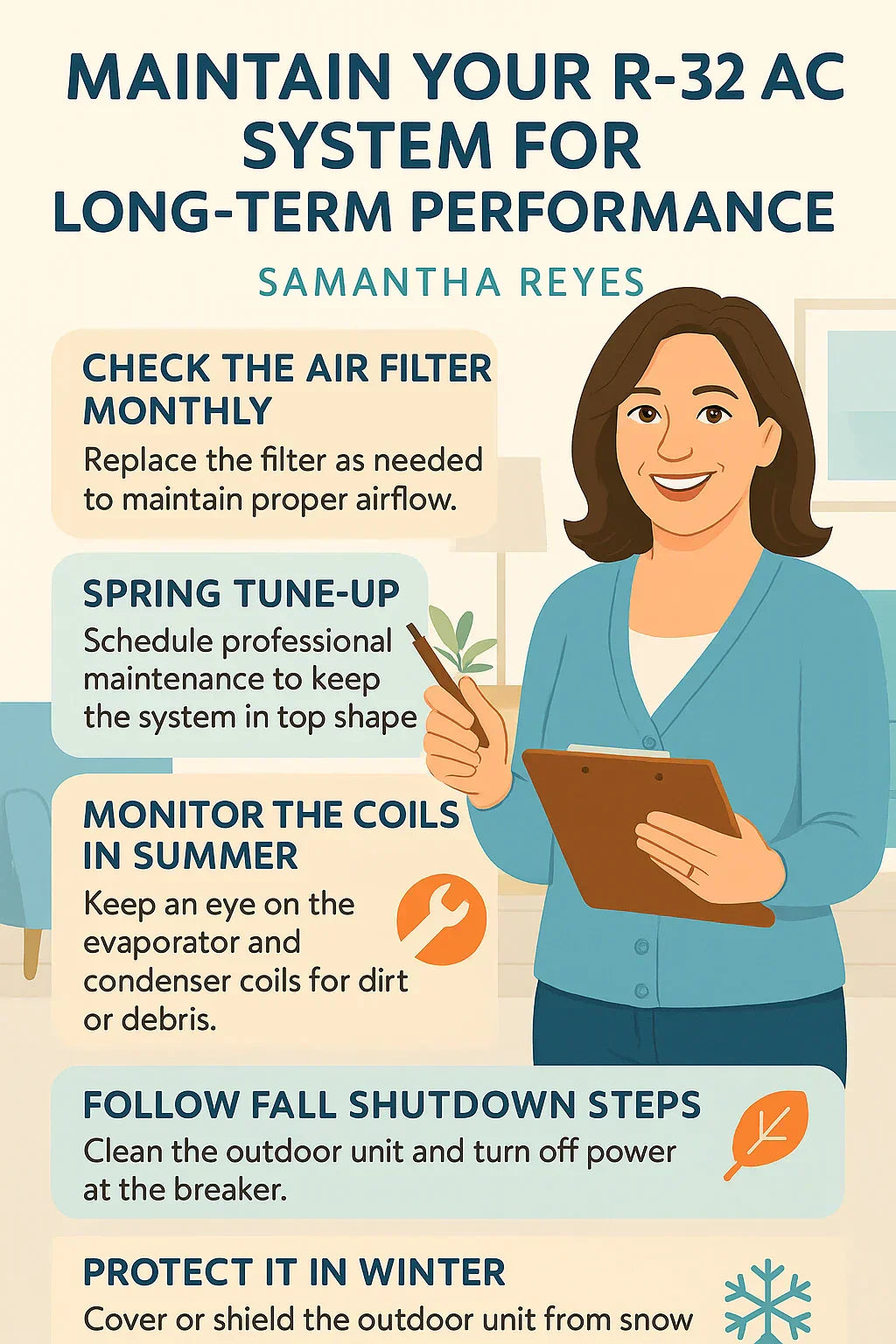A complete homeowner's guide to extending the life, efficiency, and savings of your R-32 air conditioning system.
📅 Introduction: Why Maintenance Matters More Than Ever
R-32 air conditioners are designed to be more efficient, environmentally friendly, and future-ready. But like all HVAC systems, their performance and lifespan depend heavily on regular care.
For proactive homeowners like Samantha Reyes, maintenance isn’t just a seasonal chore—it’s an investment in comfort, efficiency, and peace of mind. This guide walks you through everything you need to know to keep your 3-ton R-32 AC system running like new for the long haul.
⚖️ What Makes R-32 Maintenance Unique?
R-32 Refrigerant at a Glance:
-
Low global warming potential (GWP)
-
Classified as A2L: mildly flammable
-
Requires certified handling under EPA Section 608
Maintaining an R-32 system involves many of the same tasks as a standard system, but refrigerant-related work requires special care and licensed professionals.
🌟 Monthly Maintenance Tasks
✅ 1. Check and Replace Air Filters
Frequency: Every 30–60 days during cooling season
Why it matters: Dirty filters reduce airflow and efficiency, cause freeze-ups, and overwork the blower motor.
DIY Tip: Use MERV 8–11 filters for a good balance of filtration and airflow.
🚮 2. Keep Outdoor Unit Clear
Frequency: Monthly visual inspection
What to do:
-
Remove leaves, dirt, and debris
-
Maintain 2 ft. clearance around unit
-
Hose off fins if visibly dusty
Tool needed: Garden hose with low pressure spray
🌡️ 3. Monitor Thermostat Settings
Frequency: Ongoing
-
Use a programmable or smart thermostat to optimize run times
-
Avoid large temp swings (more than 4°F)
Recommended: Energy Star Smart Thermostat Guide
🌊 Spring Start-Up Maintenance
🍃 1. Schedule a Professional Tune-Up
Call an R-32 certified technician to:
-
Check refrigerant pressure and look for leaks
-
Inspect compressor and electrical connections
-
Clean condenser and evaporator coils
-
Verify thermostat calibration
Cost: $100–$200
✉️ 2. Clean Indoor Coil and Drain Line
Clogged coils and drain lines lead to poor cooling and water leaks.
DIY Tip: Use a coil cleaning spray and flush the drain line with vinegar or warm water.
Visual guide: Carrier Coil & Drain Maintenance
🌬️ Summer Efficiency Checks
🌬️ 1. Watch for Ice or Leaks
Signs of problems:
-
Ice on refrigerant lines
-
Weak airflow or longer cooling times
-
Water pooling near the air handler
If these occur, shut off the system and call a pro.
Learn to spot trouble: Goodman AC Troubleshooting
⏳ 2. Log Run Times and Utility Usage
Compare energy bills month-to-month. Unexpected increases may indicate:
-
Failing capacitor
-
Leaky ducts
-
Undetected refrigerant issues
Tool tip: Smart thermostats like Ecobee or Nest track run time and energy data.
🌿 Fall Shut-Down Preparation
🚼 1. Deep Clean the Outdoor Unit
After a summer of use:
-
Disconnect power
-
Remove fan grill and vacuum debris
-
Use coil cleaner or warm water to remove buildup
🌲 2. Protect Against Leaves and Ice
Install a breathable cover or barrier around the unit (don’t fully enclose). This prevents:
-
Ice buildup on coil
-
Rodent nesting
-
Moisture trapping
✏️ 3. Record Warranty-Related Issues
If you noticed anything unusual over the season, file it with your contractor or the manufacturer.
Register your unit here: AHRI Directory Lookup
❄️ Winter Off-Season Maintenance
Even if you're not using cooling in winter:
-
Check for snow or ice on the outdoor unit
-
Ensure the system is still powered for thermostat updates or heat pump backup
-
Cover thermostat if unused to prevent accidental activation
Bonus: Schedule spring service before the HVAC rush begins.
📊 Annual Service Checklist
| Task | DIY or Pro? | When to Do It |
|---|---|---|
| Replace air filters | DIY | Every 1–2 months |
| Clean outdoor coils | DIY or Pro | Spring & Fall |
| Inspect refrigerant levels | Pro only | Spring or Summer |
| Calibrate thermostat | Pro | Spring |
| Clear condensate drain | DIY | Spring & Fall |
| Verify system match (AHRI) | Pro | After install or major repair |
⚠️ When to Call a Professional
-
Ice or frost on outdoor lines or indoor coil
-
Unusual hissing or bubbling (refrigerant leak)
-
Water leaks from ceiling or floor near air handler
-
Thermostat goes blank or system won’t start
-
Utility bills spike suddenly without changes
Find a licensed tech: North American Technician Excellence (NATE)
🤝 Contractor Maintenance Plans: Worth It?
Most R-32-friendly HVAC companies offer:
-
2 tune-ups/year
-
Filter delivery service
-
Priority repair scheduling
-
Warranty record keeping
Cost: $150–300/year — may save you more in energy and repair bills
🛋 Long-Term Warranty Protection Tips
-
Register equipment within 60–90 days of installation
-
Use AHRI-matched indoor/outdoor systems to avoid coverage gaps
-
Keep maintenance records (filter changes, pro visits)
-
Only use R-32 certified technicians for repairs or you risk voiding the warranty
Tip: Save receipts and digital photos of each maintenance step in a home HVAC folder.
🔧 Final Thoughts: Build a Habit, Not Just a To-Do List
Maintaining your R-32 AC system isn't about adding tasks to your calendar—it's about building a sustainable home routine that protects your investment.
For Samantha Reyes and homeowners like her, the result is clear: lower utility bills, better cooling, and an air conditioner that performs at its peak for 15–20 years.
Ready to get started? Bookmark this guide and schedule your next service today.
In the next topic we will kow more about: Comparing R-32 vs. R-410A: What’s Better for Your Next AC System?







